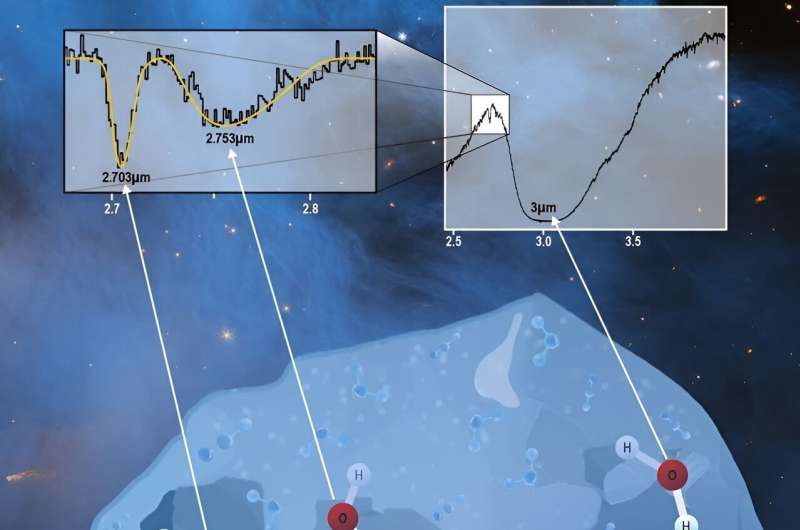This article has been reviewed according to Science X's editorial process and policies. Editors have highlighted the following attributes while ensuring the content's credibility:
fact-checked
peer-reviewed publication
trusted source
proofread
JWST sheds light on the structure of interstellar water ice

Using the James Webb Space Telescope (JWST), a team of researchers including Paola Caselli, Barbara Michela Giuliano and Basile Husquinet from MPE, have probed deep into dense cloud cores, revealing details of interstellar ice that were previously unobservable. The study, published in the journal Nature Astronomy, focuses on the Chamaeleon I region, using JWST's NIRCam to measure spectroscopic lines toward hundreds of stars behind the cloud.
For the first time, weak spectroscopic features known as 'dangling OH' have been detected, indicating water molecules are not fully bound in the ice. These features could trace the porosity and modification of icy grains as they evolve from molecular clouds to protoplanetary disks. This discovery enhances our understanding of ice grain structure and its role in planet formation.
Thanks to the unprecedented sensitivity of the JWST, we are able to probe ices deep within dense cloud cores, where extinction is so high that they eluded previous observatories.
These lines of sight are the missing link between the initial formation of ices on dust grain surfaces in molecular clouds and the aggregation of icy grains into icy planetesimals, a still little-understood process that occurs in the protoplanetary disk surrounding a new star. Peeking deep into the birthplace of stars will give new clues to these modifications of icy grains.
In the Ice Age program targeting the Chamaeleon I region, a dense cloud region close to us in the Milky Way, observations of the densest part of the cloud with JWST's NIRCam instrument have allowed simultaneous spectroscopic measurements of lines of sight towards hundreds of stars behind the cloud.
The light emitted by these stars interacts with icy grains as it crosses the cloud before being captured by the JWST's large mirror and detected. Up until now, we have been able to measure the major, intense absorption features linked with major species in the ice, namely water, carbon dioxide, carbon monoxide, methanol, and ammonia.
Thanks to the large size of the telescope's mirror, we can now measure much weaker features. In-depth studies of the positions and profiles of weak spectroscopic features reveal some of the physical conditions of the object. Here, we have made the first detection of a particular set of very weak bands linked to only a small fraction of the water molecules in the ice.
The spectroscopic features, named 'dangling OH' by laboratory astrophysicists who have measured them in laboratory ices for decades, correspond to water molecules that are not fully bound into the ice, and could trace surfaces and interfaces within the icy grains, or when the water is intimately mixed with other molecular species in the ice.
The 'dangling OH' features lie in a spectral region that is inaccessible from the ground and so, while they have been actively searched for since the 1990s, the previous space observatories covering that spectral range lacked the combination of spectral resolution and sensitivity required to detect them, providing only upper limits.
Now in the JWST era, we can use these signatures to trace icy grain modification on the journey to planet formation. It has long been anticipated that, if detected, these signatures could be used to trace the porosity of the ices, i.e. their presence would signal 'fluffy' grains with high porosity while their absence would signal compaction and aggregation.
Although this simple interpretation remains under debate, the successful detection of these signatures now means that we can search for them in different environments and at different times during the star formation process to determine whether or not they can be used as a tracer of how the ice evolves under different conditions.
"The detection of the water dangling bond feature in the ice mantles demonstrates the importance of laboratory astrophysics to interpret JWST data," says Barbara Michela Giuliano, one of the authors.
"Detailed information on the physical properties of the observed ices still requires extensive support from the laboratory to disentangle the spectral properties observed within dense regions of the interstellar medium and protoplanetary disks. Here at CAS we are happy to provide such support," she adds.
"The high sensitivity of JWST, together with impressive advancements in laboratory astrophysics, is finally allowing us to study in detail the physical structure and chemical composition of interstellar ices," says Paola Caselli, who—together with her Ph.D. student Basile Husquinet—also contributed to the paper.
"This is crucial to provide stringent constraints on chemical/dynamical modeling, needed to reconstruct our astrochemical history, from interstellar clouds to protoplanetary disks to stellar systems like our own. It is exciting to be part of this endeavor."
This study shows that, in the cloud, potentially 'fluffy' icy grains are present, impacting the chemistry that can occur in these regions and thus the degree of chemical complexity that can build up.
The discovery also opens a new window on studying planet formation since, ultimately, these spectral features allow us to build up an idea of the spatial distribution and variation of ices as well as how they evolve on their journey from molecular clouds to protoplanetary disks to planets.
More information: J. A. Noble et al, Detection of the elusive dangling OH ice features at ~2.7 μm in Chamaeleon I with JWST NIRCam, Nature Astronomy (2024). DOI: 10.1038/s41550-024-02307-7
Journal information: Nature Astronomy
Provided by Max Planck Society




















